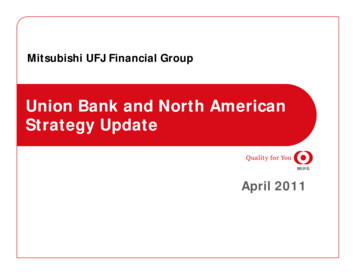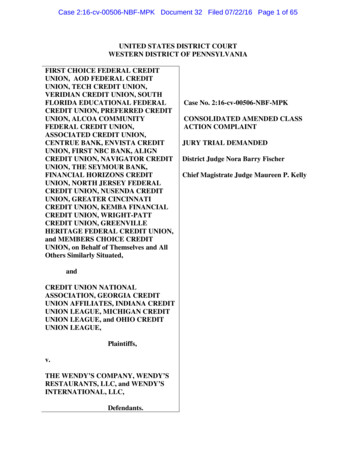
Transcription
MUFG UNION BANK, N.A. 401(K) PLANSUMMARY PLAN DESCRIPTION
TABLE OF CONTENTSINTRODUCTION TO YOUR PLANWhat kind of Plan is this? . 1What information does this Summary provide? . 1ARTICLE IPARTICIPATION IN THE PLANHow do I participate in the Plan? . 1What happens if I'm a participant, terminate employment and then I'm rehired? . 2ARTICLE IIEMPLOYEE CONTRIBUTIONSWhat are elective deferrals and how do I contribute them to the Plan? . 2What are Employee (after-tax) contributions? . 3What are rollover contributions? . 3What are In-Plan Roth Rollover Contributions? . 4What are In-Plan Roth Transfers?. 4ARTICLE IIIEMPLOYER CONTRIBUTIONSWhat is the Employer matching contribution and how is it allocated? . 5ARTICLE IVCOMPENSATION AND ACCOUNT BALANCEWhat compensation is used to determine my Plan benefits? . 6Is there a limit on the amount of compensation which can be considered? . 7Is there a limit on how much can be contributed to my account each year? . 7How is the money in the Plan invested? . 7How may I provide investment direction? . 7Will Plan expenses be deducted from my account balance? . 8ARTICLE VVESTINGWhat is my vested interest in my account? . 8What happens if the Plan becomes a "top-heavy plan"? . 8ARTICLE VIDISTRIBUTIONS PRIOR TO TERMINATION OF EMPLOYMENTCan I withdraw money from my account while working? . 9Can I withdraw money from my account in the event of financial hardship? . 9ARTICLE VIIDISTRIBUTIONS UPON TERMINATION OF EMPLOYMENTWhen can I get money out of the Plan? . 10What is Normal Retirement Age and what is the significance of reaching Normal Retirement Age? . 11What happens if I terminate employment due to disability? . 11i
In what method and form will my benefits be paid to me? . 11ARTICLE VIIIDISTRIBUTIONS UPON DEATHWhat happens if I die while working for the Employer? . 11Who is the beneficiary of my death benefit? . 12How will the death benefit be paid to my beneficiary? . 12When must the last payment be made to my beneficiary (required minimum distributions)? . 12What happens if I terminate employment, commence payments and then die before receiving all of my benefits? . 13ARTICLE IXTAX TREATMENT OF DISTRIBUTIONSWhat are my tax consequences when I receive a distribution from the Plan?. 13Can I elect a rollover to reduce or defer tax on my distribution? . 13ARTICLE XLOANSIs it possible to borrow money from the Plan? . 14ARTICLE XIPROTECTED BENEFITS AND CLAIMS PROCEDURESAre my benefits protected? . 14Are there any exceptions to the general rule? . 14What Protected Benefits have been preserved for Participants of this Plan? . 14Can the Employer amend the Plan? . 15What happens if the Plan is discontinued or terminated? . 15How do I submit a claim for Plan benefits? . 15What is the Plan's procedure for making a claim that an error was made in processing my Plan account? . 15What if my benefits are denied? . 15What is the claims review procedure? . 16What are my rights as a Plan participant? . 17What can I do if I have questions or my rights are violated? . 17ARTICLE XIIGENERAL INFORMATION ABOUT THE PLANPlan Name . 17Plan Number . 17Plan Effective Dates . 18Other Plan Information . 18Employer Information . 18Plan Administrator Information . 18Plan Trustee Information and Plan Funding Medium . 19ii
MUFG UNION BANK, N.A. 401(K) PLANSUMMARY PLAN DESCRIPTIONINTRODUCTION TO YOUR PLANWhat kind of Plan is this?MUFG Union Bank, N.A. 401(k) Plan ("Plan") has been adopted to provide you with the opportunity to save for retirement on a taxadvantaged basis. This Plan is a type of qualified retirement plan commonly referred to as a 401(k) Plan. As a participant under the Plan,you may elect to contribute a portion of your compensation to the Plan.What information does this Summary provide?This Summary Plan Description ("SPD") contains information regarding when you may become eligible to participate in the Plan, yourPlan benefits, your distribution options, and many other features of the Plan. You should take the time to read this SPD to get a betterunderstanding of your rights and obligations under the Plan.In this SPD, the Employer has addressed the most common questions you may have regarding the Plan. If this SPD does not answer all ofyour questions, please contact the Plan Administrator or other plan representative. The Plan Administrator is responsible for responding toquestions and making determinations related to the administration, interpretation, and application of the Plan. The name of the PlanAdministrator can be found at the end of this SPD in the Article entitled "General Information about the Plan."This SPD describes the Plan's benefits and obligations as contained in the legal Plan document, which governs the operation of the Plan.The Plan document is written in much more technical and precise language and is designed to comply with applicable legal requirements. Ifthe non-technical language in this SPD and the technical, legal language of the Plan document conflict, the Plan document always governs.If you wish to receive a copy of the legal Plan document, please contact the Plan Administrator.The Plan and your rights under the Plan are subject to federal laws, such as the Employee Retirement Income Security Act (ERISA) and theInternal Revenue Code, as well as some state laws. The provisions of the Plan are subject to revision due to a change in laws or due topronouncements by the Internal Revenue Service (IRS) or Department of Labor (DOL). The Employer may also amend or terminate thisPlan. If the provisions of the Plan that are described in this SPD change, the Employer will notify you.ARTICLE IPARTICIPATION IN THE PLANHow do I participate in the Plan?Provided you are not an Excluded Employee, you may begin participating under the Plan once you have satisfied the eligibilityrequirements and reached your Entry Date. The following describes Excluded Employees, if any, the eligibility requirements and EntryDates that apply. You should contact the Plan Administrator if you have questions about the timing of your Plan participation.All ContributionsExcluded Employees. If you are a member of a class of employees identified below, you are an Excluded Employee and you are notentitled to participate in the Plan. The Excluded Employees are: union employees whose employment is governed by a collective bargaining agreement under which retirement benefits werethe subject of good faith bargaining certain nonresident aliens who have no earned income from sources within the United States residents of Puerto Rico or any employee performing services in Puerto Rico part-time, temporary or seasonal employees (employees whose regularly scheduled service is less than 1,000 hours ofservice per computation period) (However, if, as a part-time employee, you actually complete at least 1,000 hours of serviceduring an eligibility computation period, you will enter the plan on the next regular entry date.) leased employees reclassified employees (an employee who was previously not treated as an employee of the Employer but you arereclassified as being an employee)1
Additional Excluded Employee provisions(1) Employees temporarily employed in the US and eligible for benefits under the Bank of Tokyo-Mitsubishi UFJ, LTD RetirementPlan, and (2) Employees who, as of June 30, 2014, were Employees of the Bank of Tokyo-Mitsubishi, UFJ, Ltd. will be ExcludedEmployees for all Contribution Types for the period from July 1, 2014 through December 31, 2014. For purposes of item (6) above,Part-time is defined as regularly scheduled to work fewer than 17.5 hours per week. Interns and co-op Employees will also beexcluded for all Contribution Types. International Employees on temporary assignment in the United States are excluded for allContribution Types See the Plan Administrator for additional information if you are not sure if this affects you.Eligibility Conditions. You will be eligible to participate in the Plan on your date of hire. However, you will actually enter the Planonce you reach the Entry Date as described below.Entry Date. Your Entry Date will be the date on which you satisfy the eligibility requirements.Additional Entry Date provisionsMatching Entry Date - for Employees hired after September 30th but before January 1st, the Entry Date shall be the first day of the nextPlan Year. See the Plan Administrator for additional information if you are not sure if this affects you.What happens if I'm a participant, terminate employment and then I'm rehired?If you are no longer a participant because of a termination of employment, and you are rehired, then you will be able to participate in thePlan on the date on which you are rehired if you are otherwise eligible to participate in the Plan.ARTICLE IIEMPLOYEE CONTRIBUTIONSWhat are elective deferrals and how do I contribute them to the Plan?Elective Deferrals. As a participant under the Plan, you may elect to reduce your compensation by a specific percentage amount and havethat amount contributed to the Plan as an elective deferral. There are two types of elective deferrals: pre-tax deferrals and Roth deferrals.For purposes of this SPD, "elective deferrals" generally means both pre-tax deferrals and Roth deferrals. Regardless of the type of deferralyou make, the amount you defer is counted as compensation for purposes of Social Security taxes.Pre-Tax Deferrals. If you elect to make pre-tax deferrals, then your taxable income is reduced by the deferral contributions so youpay less in federal income taxes. Later, when the Plan distributes the deferrals and earnings, you will pay the taxes on those deferralsand the earnings. Therefore, with a pre-tax deferral, federal income taxes on the deferral contributions and on the earnings are onlypostponed. Eventually, you will have to pay taxes on these amounts.Roth Deferrals. If you elect to make Roth deferrals, the deferrals are subject to federal income taxes in the year of deferral. However,the deferrals and, in certain cases, the earnings on the deferrals are not subject to federal income taxes when distributed to you. Inorder for the earnings to be tax free, you must meet certain conditions. See "What are my tax consequences when I receive adistribution from the Plan?" below.Deferral procedure. The amount you elect to defer will be deducted from your pay in accordance with a procedure established by the PlanAdministrator. If you wish to defer, the procedure will require that you enter into a salary reduction agreement. You may elect to defer aportion of your compensation payable on or after your Entry Date. Such election will become effective as soon as administratively feasibleafter it is received by the Plan Administrator. Your election will remain in effect until you modify or terminate it.Deferral modifications. You may revoke or make modifications to your salary deferral election in accordance with procedures that theEmployer provides. See the Plan Administrator for further information.Deferral Limit. As a participant, you may elect to defer not less than 1% of your compensation after you enter the Plan for your first PlanYear of participation, then Plan Year compensation for Plan Years that follow and not more than 75% of your compensation after you enterthe Plan for your first Plan Year of participation, then Plan Year compensation for Plan Years that follow.Deferral LimitationsElective Deferral and After-Tax combined limit is 75%.Annual dollar limit. Your total deferrals in any taxable year may not exceed a dollar limit which is set by law. The limit for 2019 is 19,000. After 2019, the dollar limit may increase for cost-of-living adjustments.Deferrals limited by nondiscrimination testing. In addition to the annual dollar limit just described, the law requires testing of thedeferrals to ensure that deferrals by HCEs do not exceed certain limits. If you are a highly compensated employee (generally more than 5%2
owners and certain family members (regardless of how much they earn), or individuals receiving wages in excess of certain amountsestablished by law), a distribution of amounts attributable to your elective deferrals or certain excess contributions may be required tocomply with the law. The Plan Administrator will notify you if and when a distribution of deferrals is required.Catch-up contributions. If you are at least age 50 or will attain age 50 before the end of a calendar year, then you may elect to deferadditional amounts in whole percentage amounts (called "catch-up contributions") to the plan for that year. The additional amounts may bedeferred regardless of any other limitations on the amount that you may defer to the plan. The maximum "catch-up contribution" that youcan make in 2019 is 6,000. After 2019, the maximum may increase for cost-of-living adjustments. Any "catch-up contributions" that youmake will be taken into account in determining any Employer matching contribution made to the Plan.You should be aware that each separately stated annual dollar limit on the amount you may defer (the annual deferral limit and the"catch-up contribution" limit) is a separate aggregate limit that applies to all such similar elective deferral amounts and "catch-upcontributions" you may make under this Plan and any other cash or deferred arrangements (including tax-sheltered 403(b) annuitycontracts, simplified employee pensions or other 401(k) plans) in which you may be participating. Generally, if an annual dollar limit isexceeded, then the excess must be returned to you in order to avoid adverse tax consequences. For this reason, it is desirable to request inwriting that any such excess elective deferral amounts be returned to you.If you are in more than one plan, you must decide which plan or arrangement you would like to return the excess. If you decide that theexcess should be distributed from this Plan, you must communicate this in writing to the Plan Administrator no later than the March 1stfollowing the close of the calendar year in which such excess deferrals were made. However, if the entire dollar limit is exceeded in thisPlan or any other plan the Employer maintains, then you will be deemed to have notified the Plan Administrator of the excess. The PlanAdministrator will then return the excess deferral and any earnings to you by April 15th.What are Employee (after-tax) contributions?Employee (after-tax) contributions. As a participant under the Plan, you may make contributions to the Plan on an after-tax basis.Employee (after-tax) contributions are subject to current taxation even though they are contributed to the Plan. However, any earnings youreceive on your after-tax contributions made to the Plan will generally not be taxed until you withdraw those amounts from the Plan. Whenyou retire or otherwise become eligible for Plan benefits, the value of your Employee Contribution Account will be used to provideadditional benefits for you or your beneficiaries.You will always be 100% vested in your after-tax contributions (see the Article in this SPD entitled "Vesting"). This means that you willalways be entitled to all of your after-tax contributions. Your Employee Contribution Account will, however, be affected by any investmentgains or losses.Limitations. There are certain limitations imposed by law on the amount of Employee (after-tax) contributions you may contribute to thePlan. These limitations will change from year to year depending upon the level of such contributions made by other participants during theyear. If your after-tax contributions exceed these limitations, the Plan Administrator will return the excess contributions to you. In addition,if you take certain hardship distributions, you may be required to suspend making after-tax contributions for months.Limitations. 1% to 10% (or such lower percentage as determined by the Plan Administrator). Elective Deferral and After-Tax combinedlimit is 75%.Withdrawal of Employee (after-tax) contributions. You may withdraw amounts in your Employee Contribution Account at any time.You will only be taxed on the portion of a distribution that consists of investment gains. You should see the Articles in this SPD entitled"Distributions Prior to Termination of Employment," "Distributions upon Termination of Employment," and "Distributions upon Death"for an explanation of how benefits (including your Employee Contribution Account) are paid from the Plan.What are rollover contributions?Rollover contributions. At the discretion of the Plan Administrator, if you are an eligible employee, you may be permitted to deposit intothe Plan distributions you have received from other plans and certain IRAs. Such a deposit is called a "rollover" and may result in taxsavings to you. You may ask the Plan Administrator or Trustee of the other plan or IRA to directly transfer (a "direct rollover") to this Planall or a portion of any amount that you are entitled to receive as a distribution from such plan. Alternatively, you may elect to deposit anyamount eligible to be rolled over within 60 days of your receipt of the distribution. You should consult qualified counsel to determine if arollover is in your best interest.Rollover account. Your rollover will be accounted for in a "rollover account." You will always be 100% vested in your "rollover account"(see the Article in this SPD entitled "Vesting"). This means that you will always be entitled to all amounts in your rollover account.Rollover contributions will be affected by any investment gains or losses.3
Withdrawal of rollover contributions. You may withdraw the amounts in your "rollover account" at any time. You should see theArticles in this SPD entitled "Distributions Prior to Termination of Employment," "Distributions upon Termination of Employment," and"Distributions upon Death" for an explanation of how benefits (including your "rollover account") are paid from the Plan.What are In-Plan Roth Rollover Contributions?In-Plan Roth Rollover Contributions. Effective January 1, 2018, if you are eligible for a distribution from an account, you may elect toroll over the distribution to a designated Roth contribution account in the Plan (referred to as an In-Plan Roth Rollover Contribution). Youmay only roll over the distribution directly. However, loans may not be rolled over as an In-Plan Roth Rollover Contribution.Taxation and Irrevocable election. You do not pay taxes on the contributions or earnings of your pre-tax accounts (including accountsattributable to Employer matching contributions) until you receive an actual distribution. In other words, the taxes on the contributions andearnings in your pre-tax accounts are deferred until a distribution is made. Roth accounts, however, are the opposite. With a Roth accountyou pay current taxes on the amounts contributed. When a distribution is made to you from the Roth account, you do not pay taxes on theamounts you had contributed. In addition, if you have a "qualified distribution" (explained below), you do not pay taxes on the earningsthat are attributable to the contributions.If you elect an In-Plan Roth Rollover Contribution, then the contribution will be included in your income for the year. Once you make anelection, it cannot be changed. It's important that you understand the tax effects of making the election and ensure you have adequateresources outside of the plan to pay the additional taxes. The In-Plan Roth Rollover Contribution does not affect the timing of when adistribution may be made to you under the Plan; the contribution only changes the tax character of your account. You should consult withyour tax advisor prior to making such a rollover.Qualified Distribution. As explained above, a distribution of the earnings on your Roth account will not be subject to tax if thedistribution is a "qualified distribution." A "qualified distribution" is one that is made after you have attained age 59 1/2 or is made onaccount of your death or disability. In addition, in order to be a "qualified distribution," the distribution cannot be made prior to theexpiration of a 5-year participation period. The 5-year participation period is the 5-year period beginning on the calendar year in which youfirst make the Roth rollover and ending on the last day of the calendar year that is 5-years later. See "What are my tax consequences when Ireceive a distribution from the Plan?" later in this SPD.The following limitations apply to the deemed distribution:Account restrictions. You may elect a deemed distribution for purposes of making an In-Plan Roth Rollover Contribution only from thevested portion of the following accounts: pre-tax deferral accounts1.after-tax deferrals account(s) attributable to Employer matching contributions accounts attributable to Employer nonelective contributions qualified nonelective contribution accounts rollover accounts (distributions may be made at any time) Not permitted from Prior Money Purchase accountThe law restricts any in-service distributions from certain accounts which are maintained for you under the Plan before you reach age59 1/2. These accounts are the ones set up to receive your salary deferral contributions and other Employer contributions which are used tosatisfy special rules for 401(k) plans. Ask the Plan Administrator if you need more details.What are In-Plan Roth Transfers?In-Plan Roth Transfers. Effective January 1, 2018, as a participant under the Plan, you may make an In-Plan Roth Transfer. An In-PlanRoth Transfer allows you to elect to change the tax treatment of all or some of your pre-tax accounts provided the account is 100% vested,as explained below.Taxation and Irrevocable election. You do not pay taxes on the contributions or earnings of your pre-tax accounts (including accountsattributable to Employer matching contributions) until you receive an actual distribution. In other words, the taxes on the contributions andearnings in your pre-tax accounts are deferred until a distribution is made. Roth accounts, however, are the opposite. With a Roth accountyou pay current taxes on the amounts contributed. When a distribution is made to you from the Roth account, you do not pay taxes on theamounts you had contributed. In addition, if you have a "qualified distribution" (explained below), you do not pay taxes on the earningsthat are attributable to the contributions.4
The In-Plan Roth Transfer allows you to transfer amounts from your vested pre-tax accounts to an In-Plan Roth Transfer Account. If youelect to make such a transfer, then the amount transferred will be included in your income for the year. Once you make an election, itcannot be changed. It's important that you understand the tax effects of making the election and ensure you have adequate resources outsideof the plan to pay the additional taxes. The In-Plan Roth Transfer does not affect the timing of when a distribution may be made to youunder the Plan; the transfer only changes the tax character of your account. You should consult with your tax advisor prior to making atransfer election.Qualified Distribution. As explained above, a distribution of the earnings on your Roth account will not be subject to tax if thedistribution is a "qualified distribution." A "qualified distribution" is one that is made after you have attained age 59
(1) Employees temporarily employed in the US and eligible for benefits under the Bank of Tokyo-Mitsubishi UFJ, LTD Retirement Plan, and (2) Employees who, as of June 30, 2014, were Employees of the Bank of Tokyo-Mitsubishi, UFJ, Ltd. will be Excluded Employees for all Contribution Types for the period from July 1, 2014 through December 31, 2014.











